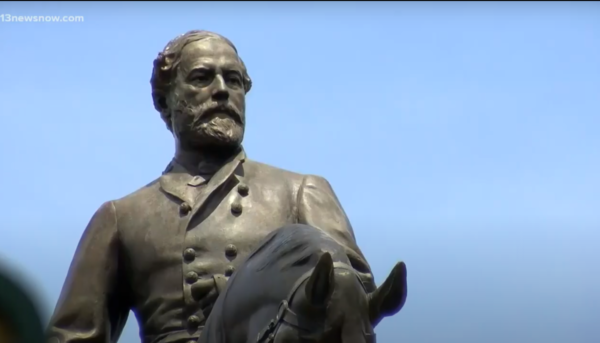The statue of Confederate Gen. Robert E. Lee in Richmond, Virginia, can be removed, the state Supreme Court ruled on Thursday. First unveiled in 1890, the statue of the Confederate general has become a symbol of racial injustice as it towered over the grassy Monument Avenue mall in Virginia’s capital city for more than 130 years.
In a 7-0 decision, the court wrote, “values change and public policy changes too.” Virginia residents had filed two lawsuits attempting to block Gov. Ralph Northam’s 2020 order to have the statue removed, but the court ruled that “restrictive covenants” in the 1887 and 1890 deeds that transferred the statue to the state and pledged that Virginia would maintain it forever do not apply any longer.
Northam called the court’s decision “a tremendous win for the people of Virginia.”
In the decision the court also cited testimony from historians who said the purpose of the statue was to honor white citizens’ defense of the antebellum South, which was defined by slavery.

“Those restrictive covenants are unenforceable as contrary to public policy and for being unreasonable because their effect is to compel … the Commonwealth to express, in perpetuity, a message with which it now disagrees,” the justices wrote.
Residents who own property near the statue, including William Gregory, argued that Virginia has promised to “faithfully guard” and “affectionately protect” the statue and that Northam was bound to maintain it an hold it “perpetually sacred,” although the court rejected the claims.
Northam announced the removal of the statue in June 2020, days after the death of George Floyd.
“That statue has been there for a long time. It was wrong then, and it’s wrong now. So we’re taking it down,” Northam said at a news conference at the time.
Richmond Mayor Levar Stoney also said when the announcement was made, “Richmond is no longer the capital of the Confederacy.”
Last year, the statue, a 21-foot bronze sculpture of Lee on horseback mounted atop a 40-foot pedestal, was vandalized numerous times with anti-racist messages and slogans, and activists showed up to pose for pictures and dance in front of the monument.
“The standing in front of it, the dancing — it symbolizes a level of freedom that Black people have never had before,” Matthew Barbour, an activist who posed for a photo in front of the statue told NPR last year. “As Africa- Americans, it’s freeing us to be able to connect with our counterparts, white people. I don’t want to sit there and talk to you about the Lee monument all the time; we need to be able to go forward and talk about something else without that being in the background.”
Attorneys for plaintiffs in the case regarding the monument claimed Northam exceeded his authority under Virginia’s Constitution by ordering the removal of the statue, and that he was bound by a 1889 joint resolution of the Virginia General Assembly to maintain the monument. But the court sided with the governor.
“Democracy is inherently dynamic. Values change and public policy changes too. The Government of the Commonwealth is entitled to select the views that it supports and the values that it wants to express,” Justice S. Bernard Goodwyn wrote.
Following the ruling, Northam said in a statement, “When we honor leaders who fought to preserve a system that enslaved human beings, we are honoring a lost cause that has burdened Virginia for too many years.” he added, “Today it is clear — the largest Confederate monument in the South is coming down.”
The state has already begun to put plans together to remove the statue and extract a time capsule believed to be tucked in its base.


